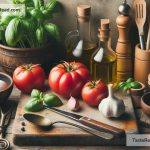My Adventure in Baking Rustic European Breads
Venturing into the art of baking rustic European breads has been nothing short of an enchanting journey back in time, bringing traditions from far-off lands right into my kitchen. The wafting aroma of freshly baked bread, the crackling sound of crust as it comes hot out of the oven, and the sheer satisfaction of slicing into something you’ve created from scratch are experiences unparalleled. Let me share with you the start of what has become a passionate endeavor into baking rustic European breads.
The Beginning: A Floury Start
My adventure began on a whim one lazy Sunday afternoon. Bored and aimlessly scrolling through social media, I stumbled upon a video of a baker pulling a beautiful golden loaf out of a wood-fired oven. The loaf had a perfect ear, a term I later learned bakers use to describe the part where the crust has beautifully split during baking, allowing the bread to expand. The video was mesmerizing, and it sparked something inside of me. I wanted to create something as beautiful and artisanal. Thus, my baking journey began.
That evening, I rummaged through my pantry and gathered all the essentials: flour, water, yeast, and salt. Little did I know, these simple ingredients would take me on a European tour of flavors and textures.
First Stop: France – The Baguette
My first attempt was the iconic French baguette. Known for its crispy crust and soft, airy interior, this bread sounded simple enough but proved to be quite a challenge. I learned about autolyse, the process of letting flour and water mix sit to develop gluten, and fermentation, which required patience I didn’t know I had. Several attempts and many YouTube tutorials later, something resembling a baguette emerged from my oven. Though far from perfect, the flavor was intoxicatingly good, and I was hooked.
Next Destination: Italy – Ciabatta
Encouraged by my modest success, I next set my sights on ciabatta, the Italian bread famous for its large holes and chewy texture. This required mastering a wetter dough, which was a messy, sticky ordeal but immensely fun. The result was a pleasingly light bread, perfect for dipping in olive oil or assembling an incredible sandwich. Each slice was a reminder of the bustling Italian markets and countryside kitchens.
Further Afield: Germany – Rye Bread
Daring to venture further, I decided to try my hand at German rye bread. This marked a departure from the familiar territory of wheat flour, introducing me into the dense, hearty world of rye. Incorporating sourdough starter into the mix, the process became a test of my newfound skills and patience. The sour, complex flavor of the final product, however, was worth every effort. It was like holding a piece of German heritage in my hands.
The Unending Journey
With each bread, I traveled across Europe from the comfort of my kitchen. I delved into sourdough, a beast of its own, and experimented with various flours and hydration levels. The process of kneading, shaping, proving, and baking became meditative, a ritual that offered comfort and excitement.
One of the most valuable lessons has been the importance of embracing imperfections. Each loaf, with its unique shape and personality, told a story. Not every attempt was Instagram-worthy, but the flavors and textures rarely disappointed. Through trial and error, I’ve learned that baking, much like life, is unpredictable and imperfectly beautiful.
Sharing the Warmth
Baking rustic European breads has been more than just a hobby; it’s been a journey of connection. Sharing freshly baked bread with family and friends, seeing their smiles and hearing their delight, has been an incomparable joy. It’s a reminder of the power of simple ingredients to bring people together, crossing cultural and geographical boundaries.
As my adventure continues, I look forward to exploring more European bread traditions, each loaf a new chapter in this deliciously fulfilling journey. Whether it’s the crusty French baguette, the chewy Italian ciabatta, or the dense German rye, rustic European breads have a magic all their own, bringing a taste of Europe into homes and hearts worldwide.
To anyone curious about baking, my advice is simple: Start where you are, use what you have, and do what you can. The journey may be floury, but it’s filled with warmth, joy, and the wonderful aroma of freshly baked bread. The adventure awaits, one loaf at a time.


